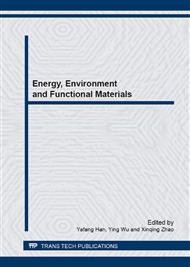p.236
p.242
p.247
p.256
p.261
p.267
p.275
p.281
p.288
Structural and Dielectric Properties of XBaZr0.2Ti0.8O3-(1-x)BiFeO3 Solid Solution Ceramics
Abstract:
xBaZr0.2Ti0.8O3-(1-x)BiFeO3 (x=0, 0.3, 0.5, 0.7) solid solution ceramics were prepared by conventional solid-state reaction method. The crystal structure and dielectric properties of xBaZr0.2Ti0.8O3-(1-x)BiFeO3 ceramics have been investigated. The result indicates that the crystal structure of solid solution ceramics changes from rhobohedral to pseudocubic structure with the increase of barium zirconate titanate content. The room temperature dielectric constant of all samples decreases with the increasing of frequency. When the temperature is in the range of 30oC~150oC, the dielectric constant of all samples increases as temperature rises. In the same temperature range, the dielectric loss of BiFeO3 ceramics increases with the rise of temperature and the dielectric loss of xBaZr0.2Ti0.8O3-(1-x)BiFeO3 (x=0.3~0.7) changes a little. The addition of barium zirconate titanate leads to the decrease of dielectric loss and leakage current for BiFeO3 ceramics.
Info:
Periodical:
Pages:
261-266
Citation:
Online since:
April 2014
Authors:
Keywords:
Price:
Сopyright:
© 2014 Trans Tech Publications Ltd. All Rights Reserved
Share:
Citation:


